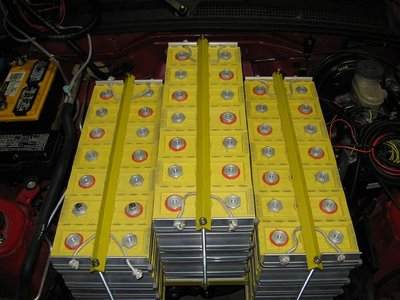Side clamping
SOURCE: http://liionbms.com/php/prismatic_tips.php#Side_clamping
-----------------------------------------------------------------------------------------------------------------------
Li-ion cells expand as their State Of Charge reaches or passes 100 %.
The pressure is not due to the
act of charging, nor to
heating; it's the
state of being fully charged that results in high pressure.
The expansion is due to mechanical expansion of the active materials, and to gases released when the cells is full, which are reabsorbed during discharge.)
A cell may be damaged if this expansion is not contained (due to layer separation)
- On one end, cylindrical cell inherently contain that expansion by virtue of their shape
- On the other end, pouch cells do not contain that expansion at all, as their walls are soft
- Prismatic cells are somewhere in between, as they do have a case, but it is not strong enough to fully contain the expansion
At what point do the cells expand, and what pressure do they exert on their walls?
It depends on the cell's design; some manufacturer's cells expand noticeably at 100 % SOC, and some only if they are grossly overcharged.
We tested a CALB cell, and found no change in the pressure exerted on its walls, even when overcharged to 4.2 V (their maximum voltage is 100 %).
Prismatic cell pressure test fixture
Therefore, we feel that, when properly protected by a BMS, these CALB cells do not need a constraint, at least not at room temperature.
(This test was performed at room temperature. We don't know what would happen if these cells were both hot and completely full.)
We do not know how cells from other manufacturers behave; unless you have tested your cells, and discovered that they do not expand at 100 % SOC, you must constrain them.
Also, if you are daring enough to use Li-ion cells without a BMS that shuts down charging when any cell is full, then constraining a cell might (
might) help it survive the abuse of overcharging.
The expansion of a stack of prismatic cells is contained by:
- Placing hard plates on either side of the stack
- Squeezing the stack of cells with the plates as far as possible (use threaded rods and screw in the nuts as far as they go)
- Clamping the lot by keeping the threaded rods in place or with metal packing straps
Prismatic cells clamped with metal plates and straps
(Left:
Honda S2000 Electric Vehicle Conversion. Right:
Casa Del Gato)
-----------------------------------------------------------------------------------------------------------------------
Consider that EVERYONE has an Opinion. It is up to the individual to asses those Opinions and use Critical Thinking to determine which is most accurate & correct. Ultimately it IS YOUR INVESTMENT and YOUR RESPONSIBILITY to determine what is the best for you.






